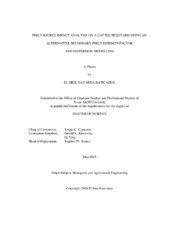| dc.contributor.advisor | Capareda, Sergio C | |
| dc.creator | Baticados, El Jirie Navarra | |
| dc.date.accessioned | 2020-09-04T19:19:56Z | |
| dc.date.available | 2020-09-04T19:19:56Z | |
| dc.date.created | 2018-05 | |
| dc.date.issued | 2018-05-07 | |
| dc.date.submitted | May 2018 | |
| dc.identifier.uri | https://hdl.handle.net/1969.1/188906 | |
| dc.description.abstract | This research was primarily focused on how much particulate matter (PM2.5) can be obtained from reactions of ammonia with sulfur dioxide inside two controlled reaction environments – flow reactor and wind tunnel. The PM2.5 generated were dominated by ammonium sulfite and ammonium sulfates based on Fourier Transform Infared (FTIR) and energy dispersive (EDS) x-ray analyses, particularly at conditions of high excess ammonia and higher O₂ inside a continuous flow reactor. The particles formed appear to be white in color ranging from powdery to crystal-like. A wind tunnel was used to simulate the interaction of fugitive fine dusts with precursors gases. Wall loss effects and heterogeneous nucleation were both observed to be the dominating factors during particle formation. The idealized 2° PM₂.₅ formed per ammonia used was calculated to be within the range of 5.64 – 10.70 mg of PM2.5 per 1000 mg of NH₃ used from the flow reactor study and 0.13 mg of PM2.5 per 1000 mg of NH₃ from the wind tunnel study. The PM ratio between the 2° PM₂.₅ and the 1° PM₂.₅ based on the wind tunnel tests was estimated to be 2.81%. A source impact analysis was conducted on a selected concentrated animal feeding operations (CAFOs) in Texas. The PM ratio generated from this research should provide an implicit conservative approach in estimating the effects of secondary PM2.5 to the total PM2.5 levels in a CAFO based on the dispersion modelling. This conservative approach assumes that both maximum impacts of secondary and primary PM2.5 occur at the same place and same time. In reality, formation of the sulfate particles should be a fairly slow process, and maximum impact maybe further downwind from the maximum primary PM2.5 impact. The knowledge gained about the formation rates, yield and characteristics of secondary PM2.5 from this research should provide sufficient vital information for future field studies in order to generate an acceptable secondary PM2.5 emission factor for CAFOs based on different geographic factors and more realistic ambient atmospheric variables. | en |
| dc.format.mimetype | application/pdf | |
| dc.language.iso | en | |
| dc.subject | Air Quality | en |
| dc.subject | Secondary Aerosols | en |
| dc.subject | Secondary PM2.5 emission | en |
| dc.subject | Ammonia | en |
| dc.title | PM2.5 Source Impact Analysis on a Cattle Feedyard Using an Alternative Secondary PM2.5 Emission Factor and Dispersion Modelling | en |
| dc.type | Thesis | en |
| thesis.degree.department | Biological and Agricultural Engineering | en |
| thesis.degree.discipline | Biological and Agricultural Engineering | en |
| thesis.degree.grantor | Texas A&M University | en |
| thesis.degree.name | Master of Science | en |
| thesis.degree.level | Masters | en |
| dc.contributor.committeeMember | Riskowski, Gerald L | |
| dc.contributor.committeeMember | Ying, Qi | |
| dc.type.material | text | en |
| dc.date.updated | 2020-09-04T19:19:57Z | |
| local.etdauthor.orcid | 0000-0002-7712-2976 | |


